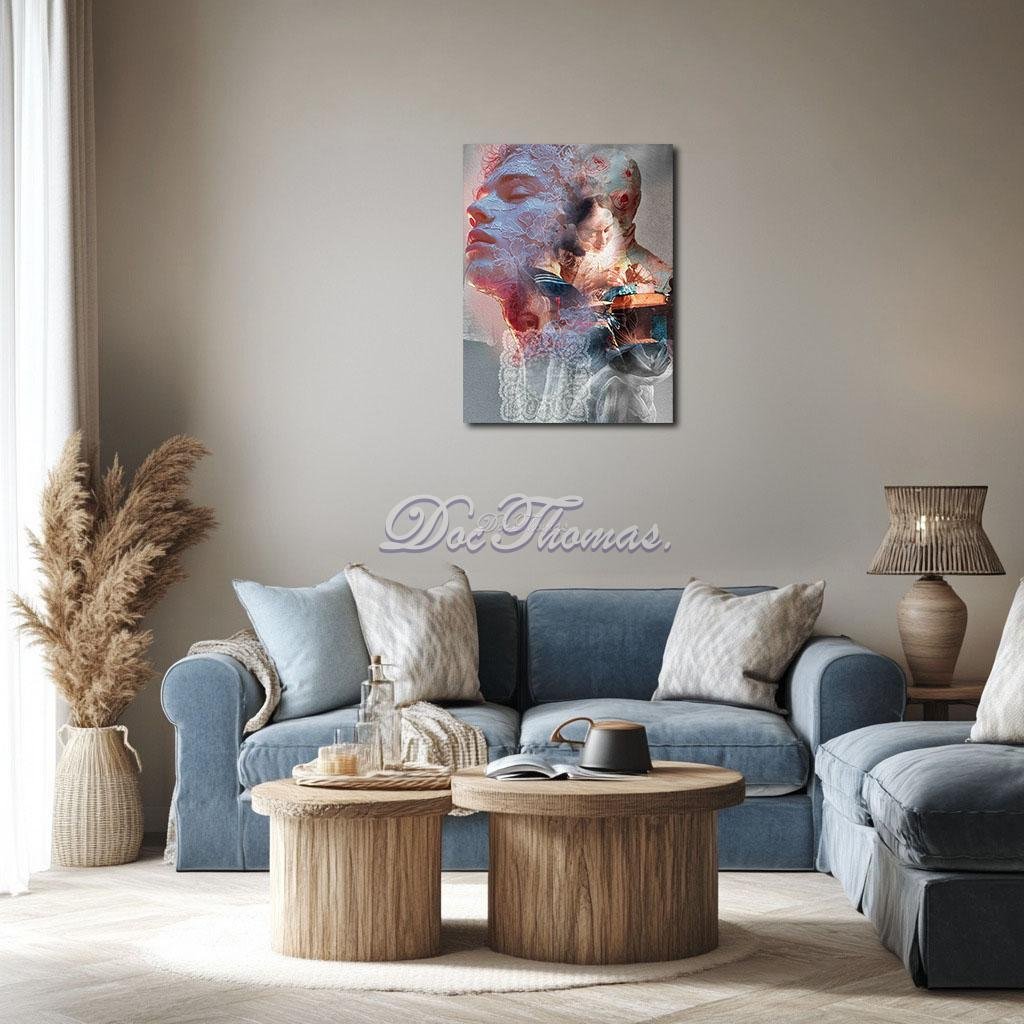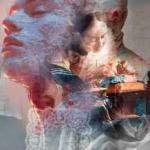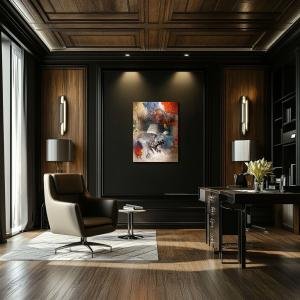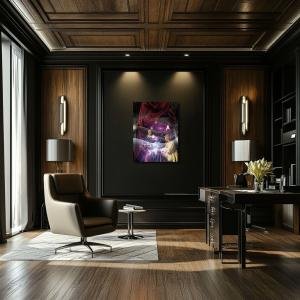Veins of Porcelain: Needlework Beneath the Breath
Veins of Porcelain: Needlework Beneath the Breath reimagines Johannes Vermeer’s The Lacemaker as a deeply layered meditation on feminine ritual, memory, and lineage. The lacemaker, still poised in concentration, is now wrapped in swirling lace and the ghostly presence of another feminine figure—eyes closed, face tilted in breath. The composition merges flesh with fabric, creating a dreamspace where color and texture speak louder than language. Soft pinks and dusted reds suggest warmth and generational memory; blues swirl in aquatic silence;
Please see Below for Details…
Hotline Order:
Mon - Fri: 07AM - 06PM
404-872-4663
Veins of Porcelain: Needlework Beneath the Breath is a surreal reimagining of Johannes Vermeer’s The Lacemaker, where delicate domesticity is no longer confined to the stitch of thread and silence of focus—it is a vast emotional field, woven through skin, lace, memory, and longing. This reinterpretation turns inward, embracing the intimacy of labor and allowing it to unravel across generations of women, consciousness, and breath. What was once a quiet portrait of feminine diligence becomes a spiritual chrysalis—where devotion and discipline transform into a poetic geography of skin and soul.
Vermeer’s original presents a young girl entirely consumed by her needlework, her fingers steady, her gaze downward, her world narrowed to the thread and cushion. Here, that narrowness becomes a universe. Her concentration is no longer just on lace—it becomes the thread that binds emotion, identity, and memory. The lacemaker is still there, still bending over her work, but now her figure is cocooned inside a swelling orchestration of faces, fabrics, and translucent textures. Around her, another face—ethereal, with eyes closed and lips parted—emerges like a spirit from the fibers of cloth, half-wrapped in floral lace. This feminine figure doesn’t interrupt the lacemaker’s world—it is the breath behind it. She is the ancestor, the dreamer, the embodiment of what this work means. She is lace made flesh.
As the artist, my thought in reimagining The Lacemaker was to explore the unspoken psychology of feminine creation—not the outcome, but the internal landscape. To sew lace is to conjure silence into form, and I wanted to visualize that silence not as emptiness, but as echo. In the act of repetition—the same needle passes through cloth again and again—there is something sacred, something bordering on the divine. It is not mindlessness. It is trance. It is where anxiety is soothed, grief is grounded, and hope becomes tactile. I saw Vermeer’s lacemaker as more than a girl—she is a ritualist, an oracle working not with prophecy but with thread.
The color landscape of this work supports that interpretation. The soft, dusty pinks that dominate the left side of the composition suggest breath and flesh, but also tenderness—like the inside of a rose, or the warmth under a veil. These hues extend into translucent overlays of floral lace, delicate in tone yet overwhelming in scale, wrapping themselves around the face of the dreaming woman. The pink is not romantic—it is physiological. It feels like touch, like the warmth of skin after pressure, like the color of whispered memory.
The blues and creams around Vermeer’s original figure are preserved in their loyalty to her context, but I allowed them to deepen—to move from the physical fabric of her dress into something almost aquatic. The blues here represent depth, time, and emotional distance. They swirl subtly around her hands, adding weight to her movements, making her seem submerged in the act of creation. The cream colors reflect the fabric she’s working on, but they also blur into the surrounding atmosphere, as if the entire air around her is being stitched into place.
In the upper right, floral patterns bloom across the surface of another head—less defined, more ghostly—suggesting another generation or another version of self. This is a space where memory is held in pattern, not in clarity. It is the way women carry the weight of beauty and ritual through the echo of design. The flowers are not alive, but they are not dead either. They are imprints. The use of reds—soft but insistent—anchors the sacredness of the labor, tying the domestic to the sacrificial. Red here is not violence—it is lineage. The line between the hand that bleeds and the hand that creates is intentionally blurred.
Around the perimeter, especially on the lower half, we see white laces unfurling like snowflakes or coral. These are the mind’s tangents during the act of creation. They are not just decorative—they are cerebral. The repetition of pattern becomes thought. These laces stretch outward, across the foreground and into the unseen, symbolizing how the smallest work can ripple into eternity.
The grayscale shadows in the backdrop serve to anchor this dream in something grounded, suggesting that not everything beautiful is light. There is mourning here—perhaps for the generations of women whose artistry was reduced to duty, or for the personal expressions that never made it beyond the domestic realm. The grayscale is not absence—it is constraint.
Vermeer’s focus on the lacemaker’s solitude becomes a central question in this reimagination: is she alone, or is she surrounded by her entire history? In this piece, she is both. She is the girl, the mother, the dreamer, the memory. She is the hand and the lace. Her bent head becomes a timeless icon, and the needle becomes not a tool but a compass—always pointing toward the quiet art of becoming.
This reinterpretation does not discard Vermeer’s original intention. It folds into it—layering modern complexity onto classic serenity. It invites the viewer to lean closer, not to inspect technique, but to hear what silence sounds like when it’s laced into being. It is a tribute not just to what women make, but to how they endure, how they soften the world’s violence with petals and thread, how they carve meaning from repetition.
Add your review
Your email address will not be published. Required fields are marked *
Please login to write review!
Looks like there are no reviews yet.










